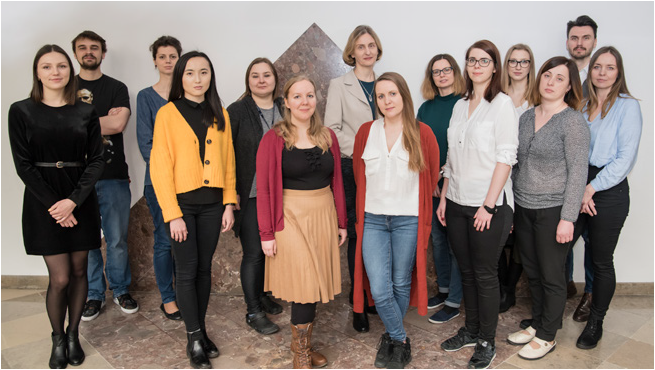 |
Marta Miączyńska, PhD, Professor
Correspondence address:
Laboratory of Cell Biology
International Institute of Molecular and Cell Biology
4 Ks. Trojdena Street, 02-109 Warsaw, Poland
Email: This email address is being protected from spambots. You need JavaScript enabled to view it.
tel: +48 (22) 597 0725; fax: +48 (22) 597 0715
|
DEGREES
2013 - Professor of Biological Sciences, nomination by the President of the Republic of Poland
2008 - DSc Habil in Cell Biology, Nencki Institute of Experimental Biology, Polish Academy of Sciences, Warsaw, Poland
1997 - PhD in Genetics, University of Vienna, Austria
1993 - MSc in Molecular Biology, Jagiellonian University, Cracow, Poland
1991 - BSc in Biological Sciences, University of Wolverhampton, UK
PROFESSIONAL EMPLOYMENT
2018-present - Director, International Institute of Molecular and Cell Biology in Warsaw, Poland
2014-2015 - Deputy Director for Science, International Institute of Molecular and Cell Biology in Warsaw, Poland
2013-2014 - Deputy Director, International Institute of Molecular and Cell Biology in Warsaw, Poland
2005-present - Professor, Head of Laboratory of Cell Biology, International Institute of Molecular and Cell Biology in Warsaw, Poland
RESEARCH TRAINING
2001-2005 - Senior Postdoctoral Fellow, Max Planck Institute for Molecular Cell Biology and Genetics (MPI-CBG), Dresden, Germany
1997-2000 - Postdoctoral training, European Molecular Biology Laboratory, Heidelberg, Germany
1993-1996 - PhD studies, Institute of Microbiology and Genetics, University of Vienna, Austria
1990-1991 - Exchange Student, University of Wolverhampton, UK
HONORS, PRIZES AND AWARDS
2020 - Corresponding Member, Polish Academy of Sciences
2019 - Member, Academia Europaea
2017 - Member, European Molecular Biology Organization
2016-2018 - Member, Council of the National Science Centre
2016 - TEAM, Foundation for Polish Science
2012 - MAESTRO, National Science Centre
2011 - Polish-Swiss Research Programme grant
2007 - Habilitation Fellowship of L’Oréal Poland for Women in Science
2006-2012 - International Senior Research Fellowship, Wellcome Trust
2006-2010 - International Research Scholar, Howard Hughes Medical Institute, USA
2006-2010 - Partner Group grant, Max Planck Society, Germany
2001-2004 - Postdoctoral Fellowship, Max Planck Society, Germany
1999-2000 - Long-Term Postdoctoral Fellowship, Human Frontier Science Program Organization
1998-1999 - Erwin Schrödinger Postdoctoral Fellowship, Austrian Science Fund
1993-1996 - Bertha von Suttner PhD Scholarship, Austrian Ministry of Science
1990-1991 - Studentship, European Community Tempus Scheme
DOCTORATES DEFENDED UNDER LAB LEADER’S SUPERVISION
M. Olchowik, A. Urbańska, A. Hupałowska, Ł. Sadowski, A. Mamińska, A. Toruń, K. Jastrzębski.
DESCRIPTION OF CURRENT RESEARCH
We study the ways in which intracellular signal transduction and membrane trafficking in endocytosis are integrated at the molecular level. We focus on proteins that play well-known roles in endocytosis to investigate their involvement in various signaling pathways and their impact on patterns of gene expression. Our efforts initially focused on studying the endosomal and nuclear roles of APPL proteins. In recent years, we broadened our interests to other multifunctional proteins that act in endocytosis and signaling. The specific projects that are developed by our group seek to answer the following questions:
-
What is the role of endosomal compartments in the trafficking and signaling of receptors for growth factors and cytokines?
-
How does the endocytic trafficking of receptors impinge on the patterns of gene expression in different signaling pathways?
-
What are the consequences of endosomal dysfunction in the cell and in the context of oncogenesis?
Endocytosis was first viewed simply as a mechanism of signal termination through the downregulation and degradation of surface receptors. However, more recent data indicate that endosomal compartments and their resident proteins play an important role in transmitting intracellular signals by transporting ligand-receptor complexes and affecting their activity inside the cell (Sadowski et al., Exp Cell Res, 2009; Miaczynska and Bar-Sagi, Curr Opin Cell Biol, 2010; Hupalowska and Miaczynska, Traffic, 2012; Miaczynska, Cold Spring Harb Perspect Biol, 2013; Cendrowski et al., Cytokine Growth Factor Rev, 2016; Szymanska et al., Semin Cell Dev Biol, 2018). Moreover, several endocytic proteins can undergo nucleocytoplasmic shuttling and interact with nuclear molecules that are involved in transcription or chromatin remodeling, changing their localization or activity, and thus may directly modulate the levels or specificity of gene transcription (Pilecka et al., Eur J Cell Biol, 2007). Importantly, some such dualfunction endocytic and nuclear proteins affect cell proliferation or act as tumor suppressors, or their expression changes in human cancers (Pyrzyńska et al., Mol Oncol, 2009).
In one of our previous projects, we identified four components of endosomal sorting complexes required for transport (ESCRTs) as novel inhibitors of nuclear factor-κB (NF-κB) signaling (Mamińska et al., Sci Signal, 2016). We found that the depletion of several ESCRT subunits in the absence of cytokine stimulation potently activated NF-κB signaling in cultured human cells, zebrafish embryos, and fat bodies in flies. These effects depended on cytokine receptors, such as lymphotoxin β receptor (LTβR) and tumor necrosis factor receptor 1 (TNFR1). We demonstrated that upon the depletion of ESCRT subunits, both receptors became concentrated on and signaled from endosomes. The endosomal accumulation of LTβR induced its ligandindependent oligomerization and inflammatory NF-κB signaling. We proposed that ESCRTs constitutively control the distribution of cytokine receptors in their ligand-free state to restrict their signaling.
As a follow-up of this work, we further investigated the mechanisms of intracellular trafficking and inflammatory signaling by LTβR (Banach-Orłowska et al., J Cell Sci, 2018). We showed that various types of endolysosomal dysfunction lead to the accumulation of ligand-free LTβR on endosomes, but the exact topology of the receptor within these compartments determines whether NF-κB signaling is induced or prevented. Most recently, we focused on the ligand-induced trafficking and signaling of LTβR (Banach-Orłowska et al., Cell Commun Signal, 2019). We found that plasma membrane cholesterol content is important for proper LTβR internalization to prevent overstimulation of the NF-κB pathway and the overproduction of cytokines. We proposed that drugs that modulate cholesterol levels could potentially improve the efficacy of LTβR-based therapies for autoimmune diseases and cancer.
In another recently published study, we uncovered an exciting connection between two ESCRT accessory proteins (VPS4A and VPS4B) and cancer (Szymańska et al., EMBO Mol Med, 2020). In humans, these ubiquitous ATPases are encoded by VPS4A and VPS4B paralogous genes. Together with other ESCRT subunits, VPS4 proteins participate in the remodeling of biological membranes that occurs during endocytosis and other intracellular processes, such as cytokinesis and exosome release. Thus, VPS4A and VPS4B are of importance for cellular homeostasis, and as enzymes they may represent convenient drug targets. By first exploring the publicly available Cancer Genome Atlas, we found that the VPS4B gene is frequently lost in many cancer types, notably colorectal cancer, along with a larger part of chromosome 18. Our clinical collaborators at the Maria Skłodowska-Curie Institute-Oncology Centre in Warsaw confirmed lower levels of VPS4B protein in tumor samples from colorectal cancer patients compared with healthy colon tissue. Using cancer cell lines that were grown in vitro and in vivo, we found that VPS4A and VPS4B paralogs were synthetically lethal, in which their simultaneous depletion (VPS4A+VPS4B) caused cell death, whereas the loss of any single paralog (VPS4A or VPS4B) was well tolerated. Our study demonstrated that VPS4B-deficient cancer cells are selectively vulnerable to perturbations of VPS4A activity. Importantly, we also discovered that dying cells that lacked both VPS4A and VPS4B proteins induced a strong inflammatory response that could evoke an anti-tumor reaction in the organism, thus supporting a positive therapeutic outcome (Fig. 1). In summary, we provided a rationale for future work to develop a VPS4 inhibitor as a putative precision therapy for patients with VPS4B-deficient cancers, such as colorectal cancer.

fig.1. Model of synthetic lethal interaction between VPS4A and VPS4B. (Left) In normal cells, both VPS4A and VPS4B act redundantly in several essential intracellular processes. The single depletion of either paralog (e.g., VPS4A) is well tolerated because the unperturbed expression of the other paralog alone (e.g., VPS4B) can compensate for its downregulated counterpart. (Right) Cells that have lost VPS4B expression (e.g., because of oncogenic genome rearrangements) rely exclusively on VPS4A activity. The inactivation of VPS4A in these cells leads to synthetic lethality, accompanied by the strong induction of an inflammatory response and the release of immunogenic DAMPs. Immunomodulatory molecules that are released by dying VPS4A+VPS4B-deficient cancer cells can elicit paracrine effects on primary immune cells, such as reprogramming of macrophages toward the M1 anti-tumor phenotype. Author: Ewelina Szymańska (after Szymańska et al., EMBO Mol Med, 2020)

Lab Leader:
Senior Researchers:
Postdoctoral Researchers:
PhD Students:
-
Marta Wróbel, MSc
-
Agata Poświata, MSc
-
Malwina Grębowicz, MSc
Volunteer:
Lab Technician:
Laboratory Support Specialist:



